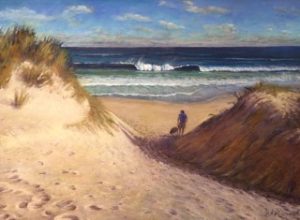
20 February to 26 March 2018.
Opening is from 2 to 4 pm on Sunday 25th February 2018. All welcome.
ON DECEMBER 1, 1955, the frenzy over ‘The Wonthaggi’s Monster’ mystery began, and it was on that day that Tom Gannon, editor of the Powlett Express, began writing ongoing articles about claims of sightings of a strange animal by those living or passing through the area surrounding Wonthaggi.
At first, the newspaper reports of Wonthaggi’s ‘Monster’ were mocked, but in later years the tone changed and many people in the area began admitting to sighting the animal. These reports described an animal resembling the characteristics of the extinct Thylacine.
According to Editor of the Bass Coast Post – Catherine Watson: “Gannon was mostly having fun with the Monster stories. Some said that if he were ever short of a story in his paper, he would add something about the monster to get things going, but the tone of the articles changed in the late 1960s when Gannon began to declare his seriousness about the existence of the monster. He referred to it as a Tasmanian Tiger-like animal, “light fawn coloured, short-haired and striped on its back and hindquarters …” In the ‘70s people began talking seriously about Tasmanian Tigers or Thylacine, as they are more commonly known now.”
Thylacinus cynocephalus had become extremely rare or extinct on the Australian mainland before British settlement of the continent, but it survived on the island of Tasmania along with several other endemic species. The last known Thylacine was known to have died in a Tasmanian Zoo in 1936. Intensive hunting encouraged by bounties is generally blamed for its extinction, but other contributing factors may have been disease, the introduction of dogs, and human encroachment into its habitat. Despite its official classification as extinct, hundreds of sightings are still reported, though none has been conclusively proven.
Proven or not, newspapers throughout Gippsland were reporting sightings of the Thylacine without any of the hysteria that accompanied earlier sightings. Mostly people were excited and impressed with what they had seen. Gannon continued to be inundated with information about sightings. Usually, it was people seeing it cross a road in an uninhabited section along the coast. Many sightings occurred near Bass/Grantville area. There have been over 106 newspaper articles written about the ‘Wonthaggi Monster’ as a result.
This exhibition attempts to visually re-imagine the stories of sightings and the ways these become cemented as part of Australian folklore, myths and legends over time. Many are still circulating amongst the locals of Wonthaggi. Australians are known for being able to tell a good yarn to the rest of the world and ongoing reports of Thylacine sightings sensationalised though news reports and social media keep the world riveted. Perhaps it is the vastness of our country and the mysteries easily hidden in our landscape that ideally contribute to Australia’s sense of identity. The ‘Wonthaggi Monster’ is indeed an intriguing example of the ongoing mysteries found in the Australian bush and its stories have inspired this collection of works.


2 Responses
Brenda Chessum
What is the exhibition on the Thylacine please? What does it consist of? Thank You. Regards Brenda Chessum.
Jeff Clark
I am a well known environmentalist and have been trying to photograph a Thylacine for some years. I have met many of my friends have seen one and often more than once. They seem to be in home areas and where they are seen often. Most people will not report their sighting for fear of ridicule. With the remote camera’s now we have a good chance to actually photograph one. One report last year was off a mother and two pups. This was in a “hot’ Sighting area. Time will tell.